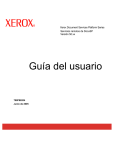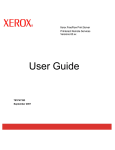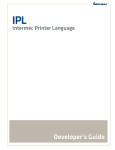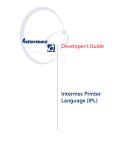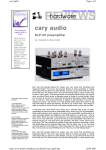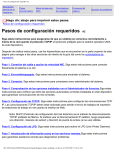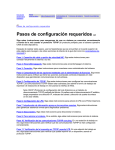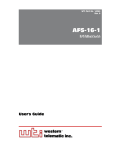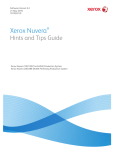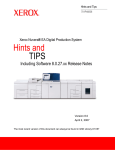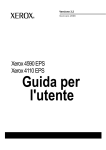Download Xerox DOCUSP 50.XX User's Manual
Transcript
Xerox Document Services Platform Series DocuSP Remote Services Versions 50.xx User Guide 701P44134 June 2005 Prepared by: Xerox Corporation Global Knowledge and Language Services 800 Phillips Road 845-17S Webster, New York 14580 ©2005 by Xerox Corporation. All rights reserved. Copyright protection claimed includes all forms and matters of copyrightable material and information now allowed by statutory judicial law or hereinafter granted, including without limitation, material generated from the software programs which are displayed on the screen such as icons, screen displays, looks, etc. Printed in the United States of America. XEROX® and all Xerox product names mentioned in this publication are trademarks of XEROX CORPORATION. One or more of the fonts listed within this document may be a registered trademark of Morisawa & Company, Ltd. or DYNALAB, Inc. Changes are periodically made to this document. Changes, technical inaccuracies, and typographic errors will be corrected in subsequent editions. Table of contents 1 What is DocuSP Remote Services? Benefits of Remote Services . . . . . . . . . . . . . . . . . . . . . . . . . . . . . . . . . . . . . . . . . . . . . . . . . . . . . 1 2 How do I start using Remote Services? Remote Services network configuration . . . . . . . . . . . . . . . . . . . . . . . . . . . . . . . . . . . . . . . . . . . . . 3 User access . . . . . . . . . . . . . . . . . . . . . . . . . . . . . . . . . . . . . . . . . . . . . . . . . . . . . . . . . . . . . . . . . . 4 Launching the Remote Services application . . . . . . . . . . . . . . . . . . . . . . . . . . . . . . . . . . . . . . . . . 4 Home page navigation . . . . . . . . . . . . . . . . . . . . . . . . . . . . . . . . . . . . . . . . . . . . . . . . . . . . . . . . . . 4 3 How can I customize application preferences? Enable or disable application features . . . . . . . . . . . . . . . . . . . . . . . . . . . . . . . . . . . . . . . . . . . . . . 7 Customize settings for data capture and transfer . . . . . . . . . . . . . . . . . . . . . . . . . . . . . . . . . . . . . . 8 Modify proxy server settings . . . . . . . . . . . . . . . . . . . . . . . . . . . . . . . . . . . . . . . . . . . . . . . . . . . . . 10 4 How do I request Xerox support? Accept a Xerox request to enable desktop sharing . . . . . . . . . . . . . . . . . . . . . . . . . . . . . . . . . . . 11 Email Contact . . . . . . . . . . . . . . . . . . . . . . . . . . . . . . . . . . . . . . . . . . . . . . . . . . . . . . . . . . . . . . . . 12 5 How does Xerox ensure quality support? Remote Monitoring (RM) . . . . . . . . . . . . . . . . . . . . . . . . . . . . . . . . . . . . . . . . . . . . . . . . . . . . . . . 14 Data Capture & Transfer . . . . . . . . . . . . . . . . . . . . . . . . . . . . . . . . . . . . . . . . . . . . . . . . . . . . . . . 14 Update Attributes . . . . . . . . . . . . . . . . . . . . . . . . . . . . . . . . . . . . . . . . . . . . . . . . . . . . . . . . . . . . . 14 Execute Script . . . . . . . . . . . . . . . . . . . . . . . . . . . . . . . . . . . . . . . . . . . . . . . . . . . . . . . . . . . . . . . 14 Download and Execute Script . . . . . . . . . . . . . . . . . . . . . . . . . . . . . . . . . . . . . . . . . . . . . . . . . . . 15 Software Updates . . . . . . . . . . . . . . . . . . . . . . . . . . . . . . . . . . . . . . . . . . . . . . . . . . . . . . . . . . . . . 15 6 How are problems identified and reported? Capture . . . . . . . . . . . . . . . . . . . . . . . . . . . . . . . . . . . . . . . . . . . . . . . . . . . . . . . . . . . . . . . . . . . . . 17 Transfer . . . . . . . . . . . . . . . . . . . . . . . . . . . . . . . . . . . . . . . . . . . . . . . . . . . . . . . . . . . . . . . . . . . . 19 Capture & Transfer . . . . . . . . . . . . . . . . . . . . . . . . . . . . . . . . . . . . . . . . . . . . . . . . . . . . . . . . . . . . 20 Files Ready for Transfer . . . . . . . . . . . . . . . . . . . . . . . . . . . . . . . . . . . . . . . . . . . . . . . . . . . . . . . . 21 File Cleanup . . . . . . . . . . . . . . . . . . . . . . . . . . . . . . . . . . . . . . . . . . . . . . . . . . . . . . . . . . . . . . . . . 21 7 Can I automatically submit meter readings? MeterAssistant . . . . . . . . . . . . . . . . . . . . . . . . . . . . . . . . . . . . . . . . . . . . . . . . . . . . . . . . . . . . . . . 23 8 Is an activity history available? Information provided on History page . . . . . . . . . . . . . . . . . . . . . . . . . . . . . . . . . . . . . . . . . . . . . 25 User Guide i Ta b le of c o nt e nts 9 How are software updates delivered? Types of software updates . . . . . . . . . . . . . . . . . . . . . . . . . . . . . . . . . . . . . . . . . . . . . . . . . . . . . . 27 ii User Guide 1 What is DocuSP Remote Services? DocuSP Remote Services is a Web-based application that enables remote communication and support with Xerox. Whenever you have service-related questions or your printing environment is not running as smoothly as you want, Remote Services can be used by you and Xerox to more quickly diagnose problems and deliver solutions. Benefits of Remote Services Remote Services allows you to: • Provide data to the Xerox Customer Support personnel and Xerox engineering personnel on-demand or automatically, to facilitate rapid problem analysis and resolution. • Share either view-only access to your desktop or share the control of your Remote Services cursor and desktop with Xerox Support. Desktop sharing enables Xerox to troubleshoot problems and remotely install software updates for you. This also allows Xerox to present remote demonstrations of new application features. • Use automated system Remote Monitoring: This feature Xerox personnel may proactively access and analyze data on the Xerox server and allow solutions to be more quickly delivered. • Download software updates. • Receive new product and application information. Remote Services features translate to benchmark productivity opportunities and machine up time. User Guide 1 What is DocuSP Remote Services? 2 User Guide 2 How do I start using Remote Services? After your Xerox customer representative installs and configures Remote Services, you can immediately access the Home page. The Home page provides links to all application features included within Remote Services. NOTE: For Remote Services registration information, please refer to the Remote Services Setup Guide. You can use the following links to access topics discussed in this section: Remote Services network configuration User access Launching the Remote Services application Home page navigation Remote Services network configuration Before Remote Services is ready to provide full service, settings for your network configuration need to be verified by your Xerox customer service representative. If your system uses a proxy server, settings to enable the network connection are defined as follows: 1. Open the [Remote Services Home: Setup: Network Settings] page. 2. Enter the HTTP Proxy Server, HTTP Proxy Port, user name and password. 3. Click [Apply New Settings]. Additionally, your customer service representative must verify settings for IP Address, Netmask, Gateway and DNS Host on the [Remote Services Home: Setup: Network Settings] page. As these settings are read-only in the Remote Services application, the settings are edited through DocuSP Setup. Once these settings are configured, Remote Services is ready to provide full network service. User Guide 3 How do I start using Remote Services? User access There are four types of users who have access to the DocuSP controller. Each type of user has different access privileges for Remote Services. The following list presents the default settings for each user. • User: Allowed access to Support Access, History and Contacts. • Operator: Access to all the features of a User and access to Problem Reporting and Support Requests. • CSE (Customer Service Engineer): Access to all system features, except the ability to enable and disable features. • System Administrator: Access to all system features. Launching the Remote Services application All features included within Remote Services are accessible through the Home page. To open the Remote Services Home page: 1. Place your cursor outside the DocuSP GUI. You may have to minimize the DocuSP GUI screen. 2. Press the <Help> key on your keyboard. The Remote Services Home page opens. Home page navigation The table that follows identifies each link located on the Home page and describes when to use each link. Link Problem Reporting 4 Description Click [Problem Reporting] to display options for capturing and transferring job and/or machine data. Data capture and transfer is usually necessary after Xerox conducts a preliminary investigation of your environment and needs additional data for further analysis. User Guide How do I start using Remote Services? Link Support Requests Description Click [Support Requests] to display a table of requests Xerox Support has forwarded to you. Execution of these requests helps to ensure optimum operability of your print environment. Different types of support requests you may receive are: User Guide • Remote Monitoring • Data Capture and Transfer • Update Attributes • Execute Script • Download and Execute Script • Software Updates Support Access Click [Support Access] to accept a verbal request from Xerox Support to activate two-way, online communication. The Support Access page is used to communicate with Xerox using a dynamic chat window and to enable permission-based desktop sharing with either desktop control or view-only privileges. MeterAssistant Click [MeterAssistant] to view a statistical summary table of automatic meter readings. This feature is available on monochrome and highlight color printers, only. Setup Click [Setup] to verify settings for the Remote Services proxy server and network settings. History Click [History] to view a status table listing all service tasks you have received from Xerox Support. 5 How do I start using Remote Services? Link 6 Description Contact Click [Contact] to open an automatically addressed email message you can send to Xerox Support. Software Updates Click [Software Updates] to download operating system patches, Remote Service patches, and DocuSP patches. This link appears on the Home page only when software updates are available. Alternately, you can access the Software Updates page via the Software Updates tab on the [Home: Support Requests] page. User Guide 3 How can I customize application preferences? There are a number of default settings you may customize. You may specify which application features are enabled or disabled. You may specify default settings for data capture and transfer, as well as network settings for your proxy server. • Enable or disable application features through the [Home: Setup: General Settings] page. • Customize settings for data capture and transfer as well as the timing of data transfer through the [Home: Problem Reporting: Settings] page. • Modify proxy server settings through the [Home: Setup: Network Settings] page. Enable or disable application features To specify which features in Remote Services are enabled: 1. Select [Home: Setup]. 2. Select the [General Settings] tab. A list of features you may either enable or disable are listed on the page. To enable a feature, place a checkmark in the feature box. Clear the check mark to disable a feature. The features listed are: • Problem Reporting–options for capturing and transferring job and machine data to Xerox Support. • Support Requests / Software Updates–accept download requests Xerox Support has forwarded to you. Download operating system patches, Remote Service patches, and DocuSP patches. Execution of these requests helps to ensure optimum operability of your print environment. • Support Access–communicate with Xerox using a dynamic chat window and to enable permission-based desktop sharing with either control or view-only privileges. • MeterAssistant–statistical summary table of automatic meter readings. You can also manage the following options: • User Guide Select a UI Language from the pull-down menu. 7 How can I customize application preferences? • Automatic Synchronization with Xerox is enabled by default. • You can enter or edit the Print Engine Serial Number. NOTE: Changing the serial number is not recommended, and should only be performed in special cases by the CSE or if Xerox specifically asks for the change to occur. 3. Click [Apply New Settings]. Customize settings for data capture and transfer The [Problem Reporting: Settings] page has an option that you can select to automatically delete captured data after it is transferred. To specify settings for captured files 1. Select [Home: Problem Reporting: Settings]. 2. Select the Capture tab. 3. If you want to delete the captured files from your system after they are transferred to Xerox, check the [Remove Capture Data after Transfer] checkbox. This eliminates the redundant storage of the files on your system. Or if you want to save the captured files clear the checkbox. 4. Enable Job Data Capture is enabled by default. If the selection box is not marked, the Job and Machine & Job data types cannot be selected on the Capture or Capture & Transfer pages. To disable this feature, remove the mark from the checkbox. 5. Note the directory location of the captured files. This field is read-only. You can verify this location when you select files to transfer to Xerox. 6. Click [Apply New Settings] to save the settings. Or, click [Restore Settings] if you do not want to modify the capture settings and you want to restore the settings that were saved last. To specify options for transferring data files 1. Select [Home: Problem Reporting: Settings]. 2. Select the Transfer tab. 3. If you want to enable the periodic capture and transfer of systems Remote Services log data, check the [Enable 8 User Guide How can I customize application preferences? Remote Monitoring] option. Selecting the information icon opens a window that presents remote monitoring details. 4. If you want to specify the time that files will automatically be transferred, use the Transfer Time selection arrows. The first field indicates the hour, the second field indicates minutes, and the third field indicates AM or PM. 5. Specify the default delivery location of transferred files. Options available are: • Xerox Support Server: Data transmitted to the Xerox Support Server must be associated to a log number before data transmission. This number is provided by Xerox Support. • Save to CD: If desired, the operator may store captured data using CD writer when one is available. • FTP Server: If your system is functioning on a private network, the operator may install the Remote Services Proxy agent which allows data communication between a private network and a Xerox FTP site. a. Enter the URL of the FTP server. b. Enter the path of the shared directory on the FTP server. c. Enter the server user name. d. Enter the server password which will automatically enable system login. 6. Click [Apply New Settings] to save the settings. 7. Or, click [Restore Settings] if you do not want to modify settings and you want to return to the system default. By default the Server Address, Share Path, Username, and Password are blank. User Guide 9 How can I customize application preferences? Modify proxy server settings To modify proxy server settings: 1. Select [Home: Setup: Network Settings] page. 2. System administrators can modify the system settings of the HTTP and FTP proxy servers: • HTTP Proxy Server • HTTP Proxy Port • FTP Proxy Server • FTP Proxy Port • Username (distinct usernames may be utilized for HTTP Proxy and FTP Proxy) • Password (distinct passwords may be utilized for HTTP Proxy and FTP Proxy) • Connectivity information can be viewed and is read only. 3. Click [Apply New Settings]. 10 User Guide 4 How do I request Xerox support? When you want to request assistance from Xerox Support, you can call the Xerox Support Hotline through standard support procedures. If Xerox Hotline support is unable to immediately resolve your issue or concern, you will be asked to click the [Home: Support Access] link to enable remote desktop sharing. Desktop sharing enables Xerox to remotely troubleshoot problems quickly in real-time. You can also send Xerox an email message that describes your questions or comments through Remote Services. Accept a Xerox request to enable desktop sharing To enable desktop sharing: 1. Click [Home: Support Access]. A support dialog box opens. 2. Enter your name, contact information and a description of your question or issue. User Guide 11 How do I request Xerox support? 3. Click [Submit]. Your request is placed in a queue.Your queue displays in the eCare Support dialog window. When Xerox Support responds to queue, a two-way dynamic chat window opens. Use this chat window for an instant, text based conversation with Xerox Support. If Xerox Support wants to view your desktop, you will receive a Invite Observe or Invite Control request in the chat window. • If Xerox Support needs to control your mouse and desktop, you will receive a Invite Control message. You may either accept or reject this invitation. Invite Control enables Xerox Support to direct you to specific screen or menu locations or to directly resolve operational issues. • If Xerox Support wants to share your desktop with viewonly rights, you will receive an Invite Observe message. You may also accept or reject this invitation. Invite Observe enables Xerox Support to remotely present training demonstrations. Email Contact When you want to communicate with Xerox Support without enabling desktop sharing, you may send Xerox an email message from the Remote Services Home page. To send a message to Xerox Support: 1. Select [Home: Contact...] to open an email message that is automatically addressed to Xerox Support. 2. Enter a description of your issue into the Subject field. 3. Enter your text message. 4. Click [Send]. Or, if you want to close the message window without sending the message, click [Close Window]. 12 User Guide 5 How does Xerox ensure quality support? To ensure and maintain optimum operability of your print environment, Xerox Support may ask you to perform a specific task or action. These requests are called Support Requests. Each time Xerox sends you a Support Request, a link to download the request is placed on the Home page. Click this link to open the Support Requests page. You may either accept or reject any Support Request. Support Requests you accept are downloaded to your system where Xerox Support can connect to your system and execute the request. Different types of Support Requests that you may receive are: • Remote Monitoring (RM) • Data Capture & Transfer • Update Attributes • Execute Script • Download and Execute Script • Software Updates Information included on the Support Requests page includes: • ID–identifies the tracking number assigned. Click an ID link to pop open additional details. • Type–classifies requests by OS or patch. • Status–indicates whether you have accepted, completed, or rejected the request. • Date/Time–indicates the date you received the request. To accept or reject a request, perform the following: • To accept and install an update, click the desired row and click the [Accept] button. • To reject an update and remove a support request from the available list, click the desired row and click the [Reject] button. A rejected update may be accepted at a later time. By default, Remote Services checks for new Support Requests on startup, and then once a day. To manually check the Xerox Support Server for new Support Requests, click the [Get New] button. New Support Requests may take a few minutes to arrive. To refresh the display to include Support Requests that have just arrived, click the [Refresh Table] button. New entries are highlighted as New! under the Refresh column. User Guide 13 How does Xerox ensure quality support? Remote Monitoring (RM) Remote Monitoring is a timer-based script that automatically captures and transmits machine data to Xerox Support. Job data is not captured using Remote Monitoring. Collected machine data is transmitted to Xerox Support at regular intervals. Xerox uses this information to identify and resolve issues. When you receive a Remote Monitoring Support Request, you only need to accept the request once. The scheduled data collection and transfer will then occur automatically. NOTE: To protect your privacy, Job data is not transmitted to Xerox at regular intervals. Job data is transmitted only if a Job Capture is performed directly via the Capture or Capture & Transfer page. Data Capture & Transfer Data Capture & Transfer is a script that customers are asked to execute when additional job and machine data is required. When Xerox Support needs additional data, you will receive a Support Request. Update Attributes The Update Attributes Support Request enables the Xerox Support team to remotely update device attributes. Examples of device attributes typically included within this type of Support Request include enabled or disabled logging, the frequency of Remote Monitoring (RM), or the canceling of a Support Request. Execute Script The Execute Script Support Request enables the Xerox Support team to execute an installed script. For example, you may be asked to execute a script that restores machinery to the factory settings. 14 User Guide Download and Execute Script This Support Request enables the Xerox Support team to remotely load an additional script on a device and immediately initiate script execution. Software Updates Each time the Remote Services application opens, the system checks for software updates from the Xerox Support Server. Software updates can be accepted or rejected. For additional information, see: How are software updates delivered? User Guide 15 How does Xerox ensure quality support? 16 User Guide How are problems identified and reported? 6 How are problems identified and reported? Xerox Support may identify and resolve most of your operational issues when you grant permission to observe or control your mouse and desktop through the [Home: Support Access] page. Sometimes, however, Xerox Support may need additional machine and/or job data to more fully analyze your system. The [Home: Problem Reporting] page enables you to capture machine and/or job data and then automatically transmit the additional data to Xerox Support. You may either capture and transfer data to Xerox as it is being recorded or capture data at one point in time, and then transfer the data file at another time. Data may be transferred directly to your Xerox Support Server, to a local FTP site, or to a CD writer. The Problem Reporting page displays the following options: • Capture • Transfer • Capture & Transfer • Files Ready for Transfer • File Cleanup NOTE: For information on the Capture and Transfer setup process, see: Customize settings for data capture and transfer If your system is not always connected to the network, your site operator may store the data file on a local drive or CD. When a network connection is established your operator can then use the Transfer feature to transmit the captured data. NOTE: Only one process per service may run at a time. Capture This procedure explains how to capture machine and/or job data. This procedure assumes you will transfer your machine and/or job data to Xerox Support at a future time. User Guide 17 How are problems identified and reported? To capture machine and/or job data 1. Select [Problem Reporting: Capture]. Once the Capture window opens, you are informed that the DFE must not be ripping or printing while a Data Capture is in progress. 2. Select a Data Type option: • Machine • Job • Machine & Job If you select Machine or Machine & Job, the following Machine capture options are available by expanding the Advanced Machine Data Type Settings menu: • Capture DFE Data Only • Capture IOT Data Only • Capture DFE & IOT Data NOTE: The Advanced Machine Data Type Settings menu is grayed out if Job is the Data Type option selected. 3. If the Data Type option you select is Job or Machine & Job, you can select a Job Type and a Job ID from the drop-lists. These menus are unavailable if you select Machine as the Data Type. 4. Enter a Call Log ID number. This field is blank by default. NOTE: The Call Log ID facilitates transmission tracking. This information is provided by Xerox Support. 5. Enter a Fault Code. The Fault Code is the status or error message number provided by the DocuSP interface. This field is optional and is blank by default. 6. Type in a description of the current issue that requires data capture. The information you enter allows Xerox to better understand the issue. This field is required and the capture process does not proceed until a problem description is entered. 7. Click the [Start Capture] button. The dialog refreshes and shows the status of the capture process. The status bar indicates the following states: • Preparing Data • Capturing DFE Data (if applicable) • Capturing IOT Data (if applicable) • Capture Completed Successfully 8. If you want to terminate the capture process before completion, click the [Cancel Capture] button. 18 User Guide How are problems identified and reported? Transfer The Transfer utility enables your site operator to transmit previously captured data as described in the topic, Capture. There are several different ways to transfer captured data. Data may be transferred directly to: • Xerox Support Server • FTP site • CD writer NOTE: The destination is set via the Problem Reporting: Settings page: Transfer tab. To transfer machine and/or job data to Xerox 1. Select either [Problem Reporting: Transfer] or the [Files Ready for Transfer] link. The Files to Transfer table opens. This table has four columns of information–the Call Log ID, Type, Capture Date, and Status columns. The Status column indicates whether the file is Not Transferred, In-Progress, or Completed. 2. Select the file you want to transfer. 3. If desired, you may click the arrow positioned before the File ID. This expands the view and displays additional file information. 4. Click the [Start Transfer] button. If the system needs additional information, a dialog box opens asking for additional information. The system validates the transfer ID provided by Xerox Support and then transfers the files to either your Xerox Support Server, an FTP site, or to a CD writer as specified on the Problem Reporting: Settings page: Transfer tab. If the files you want to transfer are more than 400 MB, you are prompted to transfer the files to a CD writer. 5. Once the transfer is completed, you can choose to perform a New Capture, New Transfer or Close Window by selecting that option. User Guide 19 How are problems identified and reported? Capture & Transfer To capture and transfer data to Xerox in a single step 1. Select [Problem Reporting: Capture & Transfer]. Once the Capture & Transfer window opens, you are informed that the DFE must not be ripping or printing while a Data Capture is in progress. NOTE: Required information fields are designated with an asterisk 2. Select a Data Type option: • Machine • Job • Machine & Job If you select Machine or Machine & Job, the following Machine capture options are available by expanding the Advanced Machine Data Type Settings menu: • Capture DFE Data Only • Capture IOT Data Only • Capture DFE & IOT Data NOTE: The Advanced Machine Data Type menu is grayed out if Job is the Data Type option selected. 3. If the Data Type option you select is Job or Machine & Job, you can select a Job Type and a Job ID from the drop-lists. These menus are unavailable if you select Machine as the Data Type. 4. Enter a Call Log ID number. This field is blank by default. NOTE: The Call Log ID facilitates transmission tracking. This information is provided by Xerox Support. 5. Enter a Fault Code. The Fault Code is the status or error message number provided by the DocuSP interface. This field is optional and is blank by default. 6. Type in a description of the current issue that requires data capture. The information you enter allows Xerox to better understand the issue. This field is required and the capture process will not proceed until a problem description is entered. 7. Click the [Start Capture & Transfer] button. The dialog refreshes and shows the status of the capture process. The status bar indicates the following states: 20 • Preparing Data • Capturing DFE Data (if applicable) User Guide • Capturing IOT Data (if applicable) • Capture Completed Successfully 8. If you want to terminate the capture process before completion, click the [Cancel Capture] button. When the capture process is complete, file transmission begins automatically. The machine and/or job data files is transferred to either your Xerox Support Server, an FTP site, or to a CD writer as specified on the Problem Reporting: Settings page. If the files you want to transfer are more than 400 MB, you are prompted to transfer the files to a CD writer. A status bar displays and notifies you when the files have successfully been transferred. To verify the successful transfer of data, you can view the [Home: History] page. Files Ready for Transfer Each time the system successfully captures machine and/or job data, a link titled Files Ready for Transfer displays on the Home page. Click this link to open the Files to Transfer table. To transfer files listed in this table, follow steps 2 through 4 in the topic; Transfer. File Cleanup Each time you capture and save machine and/or job data, a redundant copy of the files is stored on your system. To delete these duplicate files: 1. Select [Home: Problem Reporting: File Cleanup]. The File Cleanup page lists all captured files currently stored in the Data Capture Location Path directory specified on the [Home: Problem Reporting: Settings: Capture] page. The File Cleanup page has four columns of information: Call Log ID, Type, Capture Date and Status. The table entries are displayed by Capture Date, which indicates the date of the attempted file transfer. The most recent file transfer is located at the top of the column. 2. To display file details, click the expansion arrow. 3. The Status column indicates the progress of the file transmission as either Transferred, Not Transferred, Canceled, or Transmission Error. 4. Delete files by performing one of the following: User Guide 21 How are problems identified and reported? 22 • To delete a single file highlight the row and click Delete. • To delete all files listed in the table, click Delete All. User Guide 7 Can I automatically submit meter readings? Remote Services includes the feature, MeterAssistant. When this feature is enabled, all meters are automatically read and transmitted to Xerox and you do not need to call in your meter readings. You can enable or disable the MeterAssistant feature on the [Home: Settings: General] page. NOTE: MeterAssistant is available on monochrome and highlight color printers, only. MeterAssistant Once MeterAssistant is enabled, you can visit the MeterAssistant page to verify the name and reading of each meter through the [Home: MeterAssistant] page. This page will provide the following information: • The date and time of the last meter reading displays at the top of the page. • Meter Description–lists the names of each machine meter. • Meters Transmitted–displays the value of the last transmitted meter reading. • Current Meters–displays the actual meter value. To update the time and date of the last meter reading, click the [Update] button. The MeterAssistant billing table is read-only. You will be able to visit the [Home: History] page to verify that meter readings have been successfully transmitted to Xerox. User Guide 23 Can I automatically submit meter readings? 24 User Guide 8 Is an activity history available? Information provided on History page The Remote Services History page contains a list of activities that have been performed. To open the History page, click the [History] link located on the Home page. • Capture & Transfer–capture and transfer of machine and/or job data to Xerox • Remote Monitoring–if enabled, presents periodic capture and transfer of systems Remote Services log data • File Cleanup–deletion of captured files after they are transmitted to Xerox • Support Requests (formerly called Service Request Accepted)–status of Support Requests received • Remote Services Installation–software updates installed • Support Access–sessions of interactive support and desktop sharing • MeterAssistant (formerly called Billing)–if enabled, presents transmission details of automated meter readings NOTE: MeterAssistant is available on monochrome and highlight color printers, only. • Setup–identifies features of Remote Services that are enabled or disabled • Contact–email communication sent to Xerox Support. The status of each task may be either Completed, In Progress, or Canceled. Each task is give a Date/Time Stamp, which identifies the date and time you first received the task request. To view recent updates to the History table, click the [Refresh] button. To clear the history log and refresh the table to its empty state, click the [Clear] button. User Guide 25 Is an activity history available? 26 User Guide How are software updates delivered? 9 How are software updates delivered? Each time the Remote Services application opens, the system checks for software updates from the Xerox Support Server. The Remote Services Home page provides a link to software updates whenever they become available. Alternately, you can access the Software Updates page via the Software Updates tab on the [Home: Support Requests] page. Types of software updates Software updates include: • Operating System (OS) patches • Remote Services (RS) patches • DocuSP patches When a system search is complete, a list of updates display. The search filters the list to ensure compatibility with your site configuration. Information provided with each update patch include: • Patch ID • Patch type • Installation status • Date/Time stamp You may accept, install, or reject any update. User Guide • To manually check the Xerox Support Server for new Software Updates, click the [Get New] button. New Software Updates may take a few minutes to arrive. • To accept and download an update: Click the patch ID to highlight the row and then click the [Accept] button. The software automatically downloads to your system. With your permission, Xerox Support will remotely install the patch. • To reject an update and remove it from the list: Click the patch ID to highlight the row and then click the [Reject] button. A rejected update may be accepted at a later time. • To refresh the display to include Software Updates that have just arrived, click the [Refresh Table] button. 27 How are software updates delivered? 28 User Guide
































